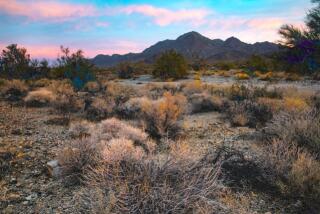Forest Service Acts on Religious Rights Complaints : Grave Sites to Rest in Peace in New Policy
- Share via
SENECA ROCKS, W. Va. — An 18th-Century graveyard on the grounds of a new U.S. Forest Service campground will be left intact through a trial policy adopted this year to recognize the religious views of American Indians.
The grave site, which forest service archeologist Janet G. Brashler believes dates from at least 1791, contains no remains of any tribal members.
But the policy, put into effect Jan. 29 by the forest service, encompasses all human burial grounds.
“It comes down to First Amendment freedom of religion rights,” Brashler said.
The grave-site policy was developed in conjunction with American Indian and archeology groups, she said. It is in effect in the Eastern and Southern regions of the forest service, which include land east of the Mississippi River, and will be put into effect nationwide if successful.
Prehistoric American Indian sites, as well as homesteads dating from the 17th, 18th, 19th and early 20th centuries, are scattered throughout Appalachia, archeologists believe.
“We’ve had lots of problems, both at the federal and state and grave-robber levels, where desecration was taking place with increasing frequency,” said Suzan Harjo, executive director of the Washington, D.C.-based National Congress of American Indians.
“Any place where there are Indian remains, it takes place.”
Although the plan specifies that the graves should be left undisturbed if possible, it does make provisions for scientific study, Brashler said.
“We need to be allowed to study and obtain samples of material--that’s going to be a bone of contention,” Brashler said.
The policy would allow some human remains to be exhumed, but only after the forest service consults with the tribes involved, Brashler said. Any human remains exhumed must be returned to the ground, she said.
“The Western European view of death relating to one’s ancestors is so different than Native Americans’ view of death and ancestry,” Brashler said. “It’s a deeply personal and spiritual thing for some of them.”
Tribal groups, especially in the Great Lakes area and in the West, were concerned that their ancestors were being unearthed from public lands with little concern for the tribes’ religious beliefs.
The forest service policy requires that agency workers in each state deal directly with tribes to work out a plan to handle each specific grave site, regardless of whether it belongs to those tribes.
“They feel that the tribal affiliation is not important,” Brashler said. “Desecration of one is desecration of all.”
In West Virginia, where no active American Indian tribes are left, administering the policy would be slightly different, she said.
“It will involve making good faith efforts to research who the people are in those graves,” Brashler said.
The tiny graveyard at Seneca Rocks is nearly hidden by brush. The graves, some marked by worn rocks that once were headstones, resemble shallow trenches. Brashler said the indentations could indicate that the people were buried in coffins.
The forest service archeologist said she believed the graveyard was in use for 50 to 60 years. One headstone contains a barely decipherable inscription including the year 1791.
The hill, overlooking Seneca Rocks, was a popular home site for settlers in the 18th and 19th centuries, Brashler said. Walking through the future campground, she identified several signs indicating that people had lived there.
Chips and flakes of stone, unearthed when workers leveled the ground for the campsite, show that the site also was inhabited by American Indians, Brashler said.
More to Read
Sign up for Essential California
The most important California stories and recommendations in your inbox every morning.
You may occasionally receive promotional content from the Los Angeles Times.










